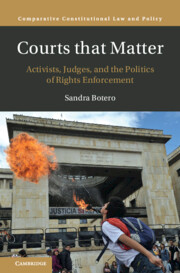Refine search
Actions for selected content:
46 results
EU DATA NULLIFICATION: CONFUSION AND THE RULE OF LAW
-
- Journal:
- The Cambridge Law Journal , First View
- Published online by Cambridge University Press:
- 03 November 2025, pp. 1-29
-
- Article
- Export citation
To Listen and to Belong. A Personal Take on Constitutionalism at Work Today
-
- Journal:
- German Law Journal / Volume 26 / Issue 2 / March 2025
- Published online by Cambridge University Press:
- 01 September 2025, pp. 350-360
-
- Article
-
- You have access
- Open access
- HTML
- Export citation
Balancing as a Means of Judicial Activism? Analysis of the German Federal Constitutional Court’s Use of Balancing Language
-
- Journal:
- German Law Journal / Volume 26 / Issue 3 / April 2025
- Published online by Cambridge University Press:
- 16 May 2025, pp. 471-492
-
- Article
-
- You have access
- Open access
- HTML
- Export citation
5 - Untold Narratives
- from Part II - Settlement Practices and Perspectives of Judges
-
- Book:
- Vanishing Legal Justice
- Published online:
- 20 March 2025
- Print publication:
- 03 April 2025, pp 99-114
-
- Chapter
- Export citation
Judicial Populism: A Conceptual and Normative Inquiry
-
- Journal:
- Law & Social Inquiry , First View
- Published online by Cambridge University Press:
- 29 November 2024, pp. 1-33
-
- Article
-
- You have access
- Open access
- HTML
- Export citation
8 - Judicial Effectiveness or Judicial Ambiguity
- from Part II - Methods of CIL Interpretation in International Courts
-
-
- Book:
- Customary International Law and Its Interpretation by International Courts
- Published online:
- 22 November 2024
- Print publication:
- 28 November 2024, pp 186-210
-
- Chapter
-
- You have access
- Open access
- HTML
- Export citation
3 - A Mutual Engagement
-
- Book:
- International Law and the Significance of Disciplinary Boundaries
- Published online:
- 21 November 2024
- Print publication:
- 28 November 2024, pp 44-83
-
- Chapter
- Export citation
In the Name of Integrity? Anticorruption Discourse of Brazilian Operation Lava Jato
-
- Journal:
- Latin American Research Review / Volume 60 / Issue 2 / June 2025
- Published online by Cambridge University Press:
- 20 November 2024, pp. 235-255
-
- Article
-
- You have access
- Open access
- HTML
- Export citation
7 - Supplementary Means
-
- Book:
- Demystifying Treaty Interpretation
- Published online:
- 07 March 2024
- Print publication:
- 14 March 2024, pp 142-156
-
- Chapter
- Export citation
6 - What’s the Purpose of ‘Object and Purpose’?
-
- Book:
- Demystifying Treaty Interpretation
- Published online:
- 07 March 2024
- Print publication:
- 14 March 2024, pp 118-141
-
- Chapter
- Export citation
Politics in Legal Disguise
-
- Journal:
- Israel Law Review / Volume 56 / Issue 3 / November 2023
- Published online by Cambridge University Press:
- 07 December 2023, pp. 320-342
-
- Article
-
- You have access
- Open access
- HTML
- Export citation
3 - Controlling Consent
- from Part I - Notions and Roles of Consent
-
-
- Book:
- Consenting to International Law
- Published online:
- 23 November 2023
- Print publication:
- 07 December 2023, pp 72-99
-
- Chapter
- Export citation
2 - Coproducing Judicial Impact
-
- Book:
- Courts that Matter
- Published online:
- 02 November 2023
- Print publication:
- 16 November 2023, pp 12-43
-
- Chapter
- Export citation
7 - Conclusions
-
- Book:
- Courts that Matter
- Published online:
- 02 November 2023
- Print publication:
- 16 November 2023, pp 168-186
-
- Chapter
- Export citation
3 - Collaborative Oversight Arenas
-
- Book:
- Courts that Matter
- Published online:
- 02 November 2023
- Print publication:
- 16 November 2023, pp 44-84
-
- Chapter
- Export citation
4 - Assessing the Effects of Monitoring Mechanisms and Legal Constituencies
-
- Book:
- Courts that Matter
- Published online:
- 02 November 2023
- Print publication:
- 16 November 2023, pp 85-128
-
- Chapter
- Export citation
5 - Low Impact Cases
-
- Book:
- Courts that Matter
- Published online:
- 02 November 2023
- Print publication:
- 16 November 2023, pp 129-144
-
- Chapter
- Export citation
1 - Introduction
-
- Book:
- Courts that Matter
- Published online:
- 02 November 2023
- Print publication:
- 16 November 2023, pp 1-11
-
- Chapter
- Export citation
16 - Colonial-Era Mixed Courts, the Compensation of Foreigners for Wrongful State Acts and the Emergence of International Judges as Guarantors of Individual Rights
- from Judicial Identity and the Judicial Role
-
-
- Book:
- The Cambridge Handbook of Foreign Judges on Domestic Courts
- Published online:
- 26 October 2023
- Print publication:
- 09 November 2023, pp 250-267
-
- Chapter
- Export citation

Courts that Matter
- Activists, Judges, and the Politics of Rights Enforcement
-
- Published online:
- 02 November 2023
- Print publication:
- 16 November 2023
